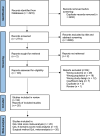Surgical outcomes on health-related quality of life in rectal prolapse: A systematic review and meta-analysis
- PMID: 40813512
- PMCID: PMC12354557
- DOI: 10.1007/s10151-025-03198-0
Surgical outcomes on health-related quality of life in rectal prolapse: A systematic review and meta-analysis
Abstract
Objectives: Rectal prolapse is a serious but not life-threatening condition. It can involve many complications, including quality-of-life changes. Surgical intervention is the standard medical treatment for these patients. In this article, we aim to investigate the quality-of-life outcomes in patients undergoing rectal prolapse surgery, compare different surgical methods, and assess different quality-of-life questionnaires to study these patients.
Data sources: We conducted a systematic literature search on PubMed, Scopus, ScienceDirect, and Embase.
Study selection: A total of 4916 studies were screened, resulting in a final 34 included studies, and 20 were included in the meta-analysis.
Interventions: Data were extracted from studies comparing the quality of life in rectal prolapse patients before and after surgery.
Main outcome measures: Except for one, all included studies reported improved quality-of-life scores. Different instruments were used to examine these patients' quality of life, but SF-36 was implemented most frequently. It comprises eight different domains, and these domains were reported in six different studies.
Results: All eight domains showed better outcomes after surgery. The final analysis was based on the surgical approach (perineal or abdominal) and showed no statistically significant superiority of any of the approaches.
Limitations: The high heterogeneity of the included studies.
Conclusion: Surgical intervention can improve the quality of life of rectal prolapse patients. However, there is no consensus on which surgical approach achieves the best outcomes. Different instruments are used to evaluate the quality of life in these patients, but there is no specific questionnaire to assess this.
Keywords: Colorectal surgery; Prolapse surgery; QoL queastionnaire; Quality-of-life; Rectal prolapse; Surgery outcome.
© 2025. The Author(s).
Conflict of interest statement
Declarations. Conflict of interest: The authors declare that there is no conflict of interest. Ethical approval: This study was conducted in full accordance with the ethical principles outlined in the Declaration of Helsinki. It was approved by the Ethics Committee of the Tehran University of Medical Sciences, Tehran, Iran, under approval number IR.TUMS.MEDICINE.REC.1403.451. Informed consent: For this type of study, formal consent is not required.
Figures













Similar articles
-
Drugs for preventing postoperative nausea and vomiting in adults after general anaesthesia: a network meta-analysis.Cochrane Database Syst Rev. 2020 Oct 19;10(10):CD012859. doi: 10.1002/14651858.CD012859.pub2. Cochrane Database Syst Rev. 2020. PMID: 33075160 Free PMC article.
-
Systemic pharmacological treatments for chronic plaque psoriasis: a network meta-analysis.Cochrane Database Syst Rev. 2021 Apr 19;4(4):CD011535. doi: 10.1002/14651858.CD011535.pub4. Cochrane Database Syst Rev. 2021. Update in: Cochrane Database Syst Rev. 2022 May 23;5:CD011535. doi: 10.1002/14651858.CD011535.pub5. PMID: 33871055 Free PMC article. Updated.
-
Prescription of Controlled Substances: Benefits and Risks.2025 Jul 6. In: StatPearls [Internet]. Treasure Island (FL): StatPearls Publishing; 2025 Jan–. 2025 Jul 6. In: StatPearls [Internet]. Treasure Island (FL): StatPearls Publishing; 2025 Jan–. PMID: 30726003 Free Books & Documents.
-
Surgery for complete (full-thickness) rectal prolapse in adults.Cochrane Database Syst Rev. 2015 Nov 24;2015(11):CD001758. doi: 10.1002/14651858.CD001758.pub3. Cochrane Database Syst Rev. 2015. PMID: 26599079 Free PMC article.
-
Antidepressants for pain management in adults with chronic pain: a network meta-analysis.Health Technol Assess. 2024 Oct;28(62):1-155. doi: 10.3310/MKRT2948. Health Technol Assess. 2024. PMID: 39367772 Free PMC article.
References
-
- Bordeianou L, Hicks CW, Kaiser AM, Alavi K, Sudan R, Wise PE (2014) Rectal prolapse: an overview of clinical features, diagnosis, and patient-specific management strategies. J Gastrointest Surg 18(5):1059–1069. 10.1007/s11605-013-2427-7 - PubMed
-
- Fan K, Cao AM, Barto W, De Lacavalerie P (2020) Perineal stapled prolapse resection for external rectal prolapse: a systematic review and meta-analysis. Colorectal Dis 22(12):1850–1861. 10.1111/codi.15338 - PubMed
-
- Wassef R, Rothenberger DA, Goldberg SM (1986) Rectal prolapse. Curr Probl Surg 23(6):397–451. 10.1016/0011-3840(86)90011-0 - PubMed
-
- Bordeianou L, Paquette I, Johnson E, Holubar SD, Gaertner W, Feingold DL et al (2017) Clinical practice guidelines for the treatment of rectal prolapse. Dis Colon Rectum 60(11):1121–1131. 10.1097/DCR.0000000000000889 - PubMed
-
- Whoqol Group (1995) The World Health Organization quality of life assessment (WHOQOL): position paper from the World Health Organization. Soc Sci Med 41(10):1403–9. 10.1016/0277-9536(95)00112-k - PubMed
Publication types
MeSH terms
LinkOut - more resources
Full Text Sources

